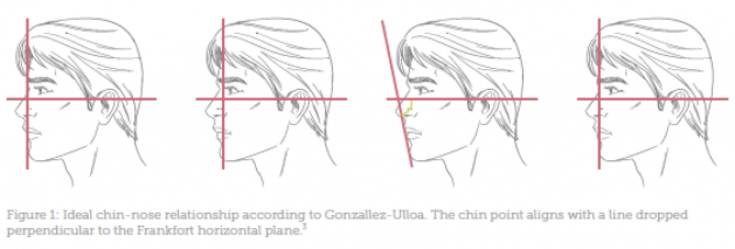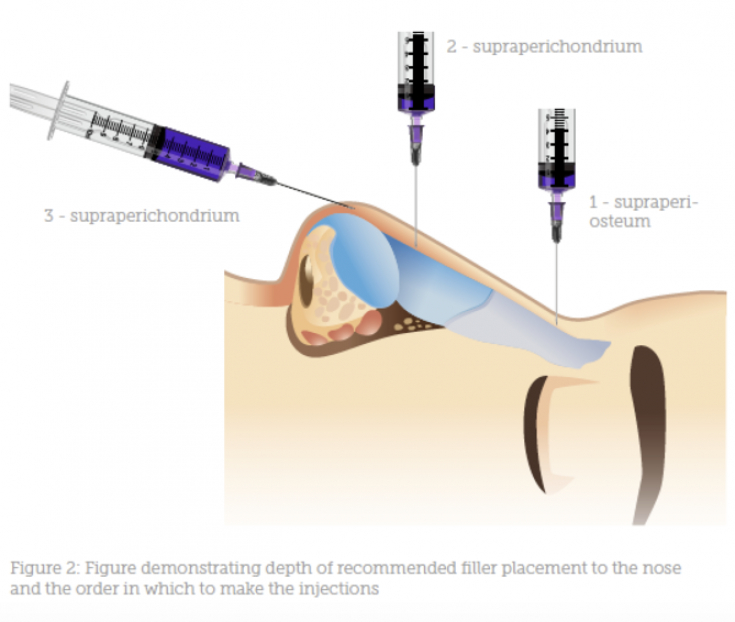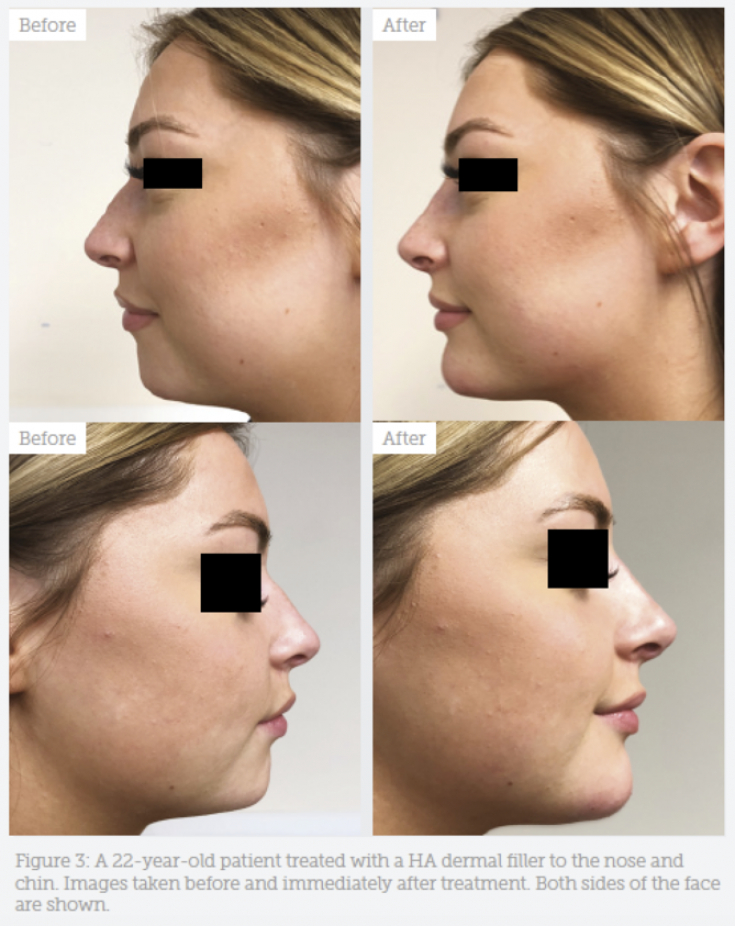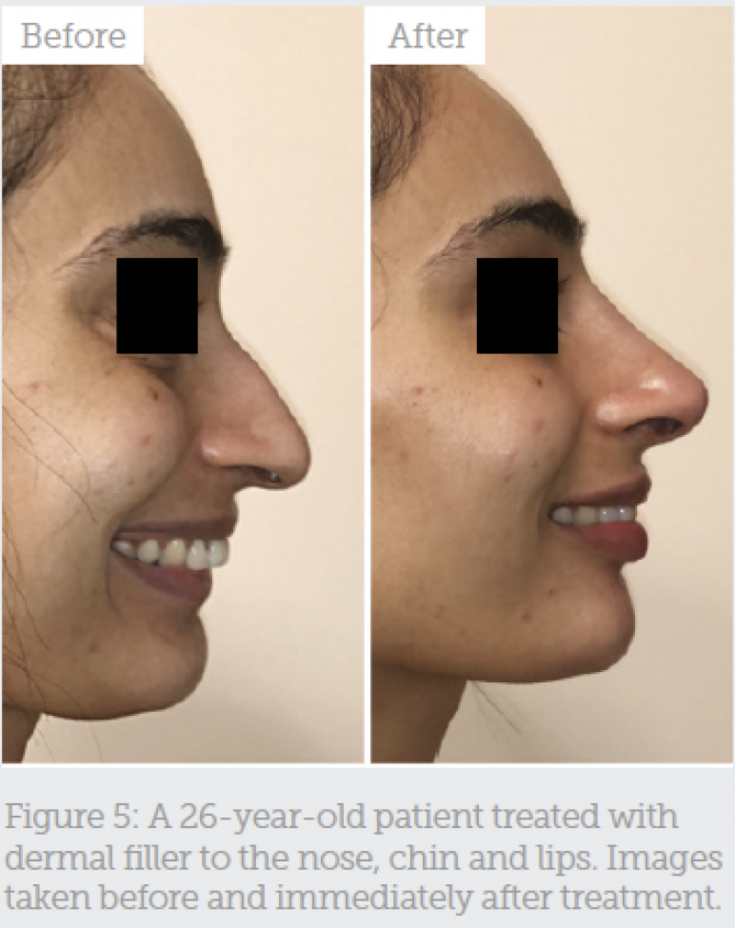Ignoring nose to chin ratio – A common mistake in preparation for injection rhinoplasty. The task of the doctor in this case – evaluate and inform the patient about the aesthetic proportions of the face and the best methods for obtaining good correction results.
Non-surgical profiloplasty, which includes injection rhinoplasty, chin augmentation and in some cases lip correction with dermal fillers, is aimed at creating physical balance and improving facial proportions. Dr. Yusra Al-Mukhtar talks about the technique of this procedure and its use in clinical practice.
Face Evaluation: Ideal Nose to Chin Ratio
One of the most popular standards describing the ideal chin-nose ratio is that given by plastic surgeon Mario Gonzalez-Ulloa in 2014 (Figure 1).
The doctor drew a line perpendicular to the Frankfurt horizontal plane (passing through the lower edge of the eye orbit and the upper edge of the external auditory meatus) and tangentially to the nasion (the intersection of the nasofrontal suture with the anterior median line).
According to González-Ulloa, on a face with ideal proportions, the pogonion (the most prominent point of the chin) should be located on this line or immediately behind it.
Non-surgical profiloplasty: features of the procedure and choice of drugs
The entire face must be assessed before the procedure. Non-surgical rhinoplasty involves injections of dermal filler and is often, but not always, aimed at correcting the hump of the nose. As a result, the bridge of the nose is aligned, the tip of the nose rises, and the nose itself is visually shortened.
Read also: Three-point non-surgical rhinoplasty: technique and results
Patients who have previously undergone surgical rhinoplasty are at greater risk of vascular complications due to prior intervention in the anatomical structures, so the doctor performing the procedure must be especially careful when working with such patients.
Chin size and position correction, including its anterior projection, length and symmetry, is necessary to obtain good aesthetic results after non-surgical rhinoplasty. In particular, the nose may visually appear larger in patients with insufficient chin projection. Achieving a balance between the proportions of the nose and chin is very important for the harmony of the face as a whole.
Non-surgical profiloplasty, which includes injection rhinoplasty, chin augmentation and in some cases lip correction with dermal fillers, is aimed at creating physical balance and improving facial proportions.
To ensure long-term results of profiloplasty, the author uses fillers with volumizing ability, high elasticity and cross-links. The filler of choice should have a high safety profile and a low risk profile. According to the author, products with a local anesthetic in the composition make the procedure more comfortable for patients.

Fig. 1: Gonzalez-Ulloa's ideal chin to nose ratio. The chin pogonion is in line with the line perpendicular to the Frankfurt horizontal plane
Side effects and complications after non-surgical profiloplasty
Contraindications for profiloplasty are similar to those for any filler procedure:
• pregnancy;
• lactation;
• immunosuppression;
• keloid scars.
Surgical methods are more suitable for correction of large noses, large nasal dorsum and class II skeletal anomalies.
Possible side effects after dermal fillers – swelling and bruising – Completely resolved after 1-4 weeks. After augmentation, the chin area may be characterized by increased sensitivity and swelling affecting the surrounding muscles. Patients should be warned that this phenomenon is absolutely normal. To reduce the degree of pain, painkillers are prescribed.
Complications of fillers can include infections and tissue necrosis. To reduce the risk of infection, you must:
• use aseptic technique during the procedure;
• do not touch the treated area and do not apply makeup for at least 12 hours after the correction.
Tissue necrosis due to vascular occlusion – a rare but very serious complication, the risk of which can be reduced by a good understanding of the local anatomy and the use of safe injection techniques.

Fig. 2: recommended nasal filler insertion depth and injection sequence
Always aspirate before inserting fillers. The author also recommends injecting the drug slowly, gradually increasing its amount. At the same time, skin color should be observed, since its blanching indicates occlusion. In case of vascular occlusion, hyaluronidase should be injected immediately.
It is important to warn the patient to seek medical attention if there is a change in skin color, ulcers, blisters, white spots, as these symptoms may indicate tissue necrosis.
It is also necessary to discuss with the patient the risk of loss of vision after the introduction of fillers: 150 cases of complications have been recorded worldwide, and the nasal area in this context – the highest risk area.
Case Study: Chin Augmentation and Injection Rhinoplasty
A 22-year-old female patient came to the author's clinic complaining of a "large" nose. In order to correct this deficiency, surgical rhinoplasty was previously performed. During the profile analysis, the author noted the presence of a hump on the nose, the dimensions of which were actually normal. The chin was flat in profile, and the chin pogonion was located at a considerable distance from the vertical line described by González-Ulloa.
Thus, a small chin visually increased the size of the nose and disturbed the physical balance of the face.
Read also: The third point of facial harmonization: the aesthetic value of chin correction
In order to improve facial proportions, the author recommended non-surgical profiloplasty to the patient: injection rhinoplasty + chin augmentation.
After proper cleaning and disinfection, the nose was corrected with HA fillers. The drug was injected into the root of the nose, directly above and below the hump, and also into the tip of the nose. In order to minimize damage, the procedure was performed with a fine needle. Each dose of dermal filler (boluses of 0.1 ml) was injected slowly into the periosteum or perichondrium after aspiration was performed. The total amount of filler injected into the nose area was 0.6 ml.
After that, the chin was augmented with the same volumizing filler based on hyaluronic acid. After the aspiration test, the dermal filler was injected perperiosteally in boluses of 0.2 ml. The purpose of the correction – an increase in the anterior projection of the pogonion and the height of the chin at its lowest point. In total, 2 ml of the drug was injected under the chin muscle.
Result of correction – more feminine and aesthetically pleasing profile (Fig. 3).
The results of non-surgical profiloplasty last approximately 12-18 months, depending on the filler used.

Fig. 3: before and immediately after nose and chin correction with HA filler
Practical case: non-surgical rhinoplasty, lip and chin augmentation
Patient, 26 years old, came to the clinic with a complaint of "long hooked nose"; and undersized lips. During evaluation, the author diagnosed a Class II malocclusion.
The correction plan in this case included non-surgical rhinoplasty as well as lip and chin augmentation.
Nasal injections were given in the following order:
1. Root of the nose – 0.2 ml per periosteum.
2. Hump point – 0.1 ml per perichondrium.
3. Tip of the nose – 0.1 ml per perichondrium.
4. The junction point of the nasal septum and upper lip – 0.1 ml of the drug in front of the nasal spine.
Dense filler with lifting ability and local anesthetic was used for injectable rhinoplasty and chin augmentation.
Chin correction (projection enlargement) required 1.5 ml of the product, which was administered in small boluses (0.2 ml each) lateral to the pogonion.
The author used 1 ml of dermal filler for lip augmentation. The main goal of correction – increase the volume of the lower lip and slightly curl it down to mask the malocclusion.
Read also: Hyaluronic acid lip correction: how to get a natural result and avoid complications

Fig. 4: before and after correction of the nose, chin and lips with dermal fillers
The results of non-surgical profiloplasty last approximately 12-18 months, depending on the filler used.
Adapted from Aesthetics







Add a comment